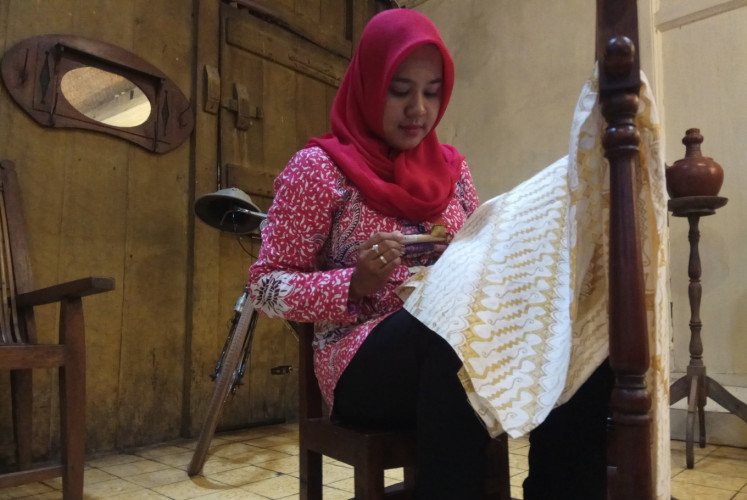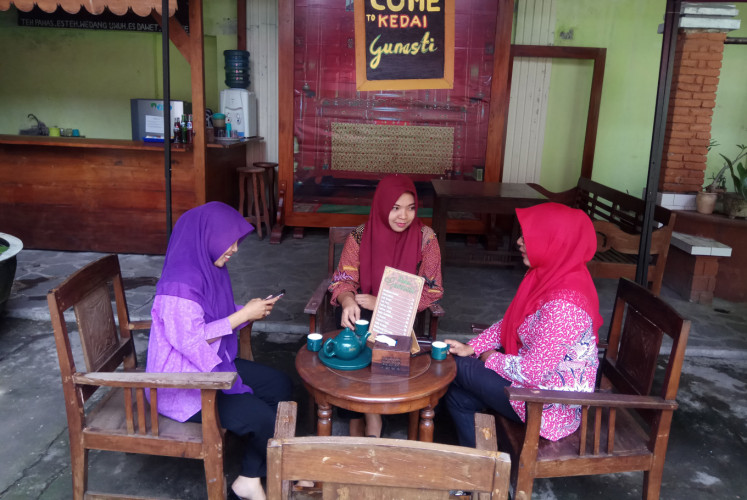Popular Reads
Top Results
Can't find what you're looking for?
View all search resultsPopular Reads
Top Results
Can't find what you're looking for?
View all search resultsSurakarta's Kauman village, a café haven lined with batik boutiques
Kauman village, the center of batik in the Central Java city of Surakarta, is full of unique coffee shops that are surrounded by traditional architecture.
Change text size
Gift Premium Articles
to Anyone
A
s the center of batik in the Central Java city of Surakarta, Kampung Kauman (Kauman village) has its own way of marketing its traditional fabrics. In addition to its revitalized historical buildings, it attracts travelers through its quaint cafés, which specialize in coffee and are surrounded by batik boutiques.
The amount of cafés has grown rapidly in the area, which is home to 40 batik home industries. Located close to Kasunanan Surakarta Palace, such cafés offer traditional drinks and foods with a distinctive atmosphere.
Cafés in Kauman village show visitors how to make batik. (JP/Ganug Nugroho Adi)Kedai Kauman, one of the cafés, is richly influenced by ethnic and retro styles in its interior. It uses vintage chairs and tables from the 1970s, accompanied with an onthel (classical) bicycle, antique radio and old cupboard filled with vintage, decorative cups and glasses. It also includes gebyok (Javanese wooden walls) that are reminiscent of traditional Javanese houses.
Nestled amid thousands of batik fabrics, Kedai Kauman serves traditional beverages, such as beras kencur (medicinal drink made from rice and herbs), wedang jahe (ginger-based drink) and wedang wuh (warm drink made from herbs). These drinks can be savored with local foods, including getuk (cassava-based snack with liquid palm sugar and coated in grated coconut), serabi (rice flour pancake with coconut milk) and pecel ndeso (steamed vegetables served with sauce made from black sesame).
Read also: Kauman & Laweyan, Surakarta's batik and heritage centers
“We don’t only want our visitors to shop for batik, but we also want them to know a different side of Surakarta, including its foods, drinks and history of batik in Kauman,” said Gunawan Setiawan, a representative of the boutique and café, on Dec. 25. “Batik is sold alongside the history in this village.”
Another café that should be visited is Kedai Gunasti. Its interior and exterior features a combination of retro, old Javanese and colonial looks. Located in a colonial building, the café-boutique offers dawet telasih (iced beverage with rice flour jelly, palm sugar and coconut milk), saparila (Sarsaparilla) and bottled temulawak (curcuma).
Visitors enjoy their time at Kedai Gunasti in Kauman village in Surakarta. The area is known for its historical buildings, quaint cafés and batik boutiques. (JP/Ganug Nugroho Adi)“For now, almost all of the boutique-houses in this area have small cafés inside – there are around 15 cafés,” said Supriyadi, a member of the Tourism Awareness Community (Pokdarwis) of Kauman village. “The owners designed the cafés in a unique way. It’s good for tourism.”
The tradition of batik-making in Kauman village dates back to the 1800s and 1900s, when a large number of abdi dalem (royal servants) of the palace lived in the area. Also posing as batik makers, they tended to preserve classic patterns, including Sidomukti, Sidoluhur, Parang and Truntum. It is different compared to batik produced in Laweyan Batik village, which tends to use modern patterns.
Kauman village also has historical buildings, such as rumah joglo (Javanese house with cone-shaped roof), limasan (pyramidal house) and architecture that is influenced by Javanese and Dutch designs. (wir/kes)













